by James Scott Bell
@jamesscottbell
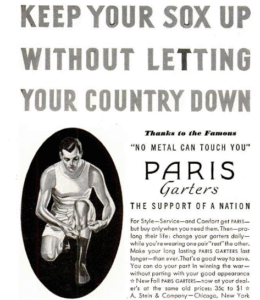 At the turn of the last century, the Second Industrial Revolution was well underway (dating roughly from the mid-19th to the mid-20th). Demographics moved from rural to urban. Cities swelled. And men faced a real problem—sagging socks.
At the turn of the last century, the Second Industrial Revolution was well underway (dating roughly from the mid-19th to the mid-20th). Demographics moved from rural to urban. Cities swelled. And men faced a real problem—sagging socks.
Oh, it was fine back on the farm, when only Bessie the cow and a few scattered chickens were witnesses to sartorial sag. But for the city-dwelling male—businessmen, newspaper reporters, plainclothes cops, or any man going to a public space like a ballgame, church, or saloon—slumping hose was a real challenge. Thus arose the men’s garter business. (It would not be until the late 1930s that synthetic fiber was patented by DuPont and made possible elastic socks.)
Novels can sag, too, in five key areas. Let’s see if we can’t make them tighter and firmer, and eliminate the need for garters.
- The Opening
We talk a lot about opening pages here, for obvious reasons. They can make or break a potential sale. (Search our archives for First Page Critiques.) I’ve written about beginning with a disturbance. This is an automatic hook. The enemy is too much backstory and exposition.
Sag Fix: Act first, explain later. Cut out all explanatory material on the first few pages. But I need the readers to know the circumstances and set up, don’t I? No! “Exposition delayed is not exposition denied.” Readers will wait a long time for exposition if they’re caught up in a disturbance.
- The Delayed Doorway
The Doorway of No Return is when the Lead is forced into the “death stakes” of the novel. It’s the turning point into Act 2 and the main plot. In classic movie structure, this happens at the 1/4 mark. In a novel, I’ve found that it’s best at the 1/5 mark. But that’s too much to think about! I just want to write my story! I hate outlines!
I hear you, pantser. Keep your pants on. Write the way that makes you happy. But if you don’t know structure, all that happy creativity may be for naught. If a reader is going along and starts feeling This story is dragging, they may not stick around.
Sag Fix: Know how and where to cut or move scenes, so that the battle is joined around the 20% mark. You can look at the total word count of your first draft to figure it out. I use Scrivener with four folders: Act 1, Act 2a, Act 2b, and Act 3. Scrivener shows me the total word count in each folder.
- Friend Scenes
There are times when you slow the action a bit to have the Lead confer with a friend or confidante or potential ally. Often these are “eating scenes,” which has its own fixes (see How to Write an Eating Scene).
Sag Fix: You can always find a way to insert tension into a friend scene. Something inside a character is making conversation difficult. For example, your Lead doesn’t want to fully open up about something, and the friend starts to probe. Brainstorm possibilities.
- The Middle
Oh boy, that sagging middle! It’s a three-bear problem: Is it too cold? Too hot? Just right? Is it too short? Too long? Too boring?
It’s funny (or nerve-wracking) how so many writers report the same problem around the 20k or 30k mark. “Holy Moly! Here I am and I’ve got 60k or more words to go! Yikes! Do I have enough going on? Too much? Is it getting out of hand? Or is this thing I’m writing just a novella? Should I make this a “trunk” novel and put it away for another time? Or should I just junk it? Is this wasted effort? Where did I put the bourbon?”
There are too many ways writers get lost in the Act 2 weeds that it is beyond one section of a blog post to deal with. (Let me modestly mention that I cover the whole subject in my book Plotman to the Rescue.)
Avoid the temptation to add “padding.” By that I mean scenes you conceive just to increase word count, as opposed to scenes that are organically related to the plot.
Sag Fixes:
- Add a true subplot. This comes in the form of an additional character who complicates the main plot for the Lead. In a thriller, it’s often a romantic or family subplot.
- Bring in a guy with a gun. This oft-quoted piece of advice is attributed to Raymond Chandler. It of course does not mean a guy with an actual gun (unless that fits your thriller or mystery mode). It can be a character with a bombshell secret, or a link to past trauma, or a connection to the “shadow story.”
- A corollary to Chandler’s tip is: Kill somebody. Pick a character in your draft and send the poor thing to their maker.
- Add a societal complication. In my Mike Romeo thrillers I usually have some issue of collective madness swirling around, muddying up the plot.
- Anti-Climax
When the final battle has been won (or in some cases, lost), and the loose ends all accounted for, wrap it up! Don’t give us pages and pages of after-plot.
Sag Fix: Add a scene that adds resonance to the ending. This is a scene that resolves a character issue for the Lead. It should be short and sweet, as it is in my favorite Bosch, Lost Light.
She lets go of her mother’s hand and extended hers to me. I took it and she wrapped her tiny fingers around my index finger. I shifted forward until my knees were on the floor and I was sitting back on my heels. She peeked her eyes out at me. She didn’t seem scared. Just cautious. I raised my other hand and she gave me her other hand, the fingers wrapping the same way around my one.
I leaned forward and raised her tiny fists and held them against my closed eyes. In that moment I knew all the mysteries were solved. That I was home. That I was saved.
This fulfills Spillane’s axiom that “the last chapter sells your next book.” Connelly has sold quite a few. Go thou and do likewise.
What plot sags have you encountered? What do you do about them?

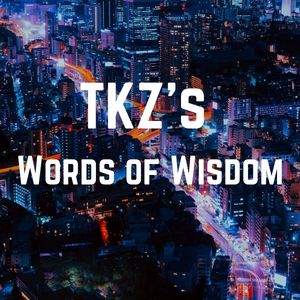




 Coming Soon!
Coming Soon!
 A case can be made that the greatest movie star of all time, the GOAT if you will, is Bette Davis. In a career spanning 50 years she never gave a bad performance, even in guest roles on TV shows like Gunsmoke and Wagon Train. That’s because acting was her life and she never wanted to give the audience short shrift.
A case can be made that the greatest movie star of all time, the GOAT if you will, is Bette Davis. In a career spanning 50 years she never gave a bad performance, even in guest roles on TV shows like Gunsmoke and Wagon Train. That’s because acting was her life and she never wanted to give the audience short shrift. Today I want to bring up a classic Davis “woman’s picture” (as they were called in WWII, to cater to all the women whose men were off fighting a war), Now, Voyager. As always, I encourage you to watch it, then refer back to these notes for craft study.
Today I want to bring up a classic Davis “woman’s picture” (as they were called in WWII, to cater to all the women whose men were off fighting a war), Now, Voyager. As always, I encourage you to watch it, then refer back to these notes for craft study. The story question: Can Kimble keep ahead of the law long enough to prove his innocence by finding the one-armed man?
The story question: Can Kimble keep ahead of the law long enough to prove his innocence by finding the one-armed man?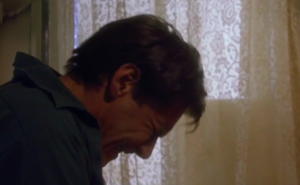 Only it turns out the cops are there to nab the Polish woman’s drug-dealing son.
Only it turns out the cops are there to nab the Polish woman’s drug-dealing son. The doctor reappears and asks Kimble to help out by taking the boy to an observation room. Kimble wheels him away, checking out the X-ray as he goes. He asks the lad a few questions about where it hurts, then changes the orders and gets the boy to an operating room for immediate attention.
The doctor reappears and asks Kimble to help out by taking the boy to an observation room. Kimble wheels him away, checking out the X-ray as he goes. He asks the lad a few questions about where it hurts, then changes the orders and gets the boy to an operating room for immediate attention.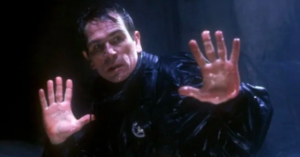 Many of the great lines in the movie were actually improvised. The most famous is from the spillway scene. Kimble has a gun on Gerard. Kimble says, “I didn’t kill my wife!” And Gerard says, “I don’t care!” Tommy Lee Jones came up with that.
Many of the great lines in the movie were actually improvised. The most famous is from the spillway scene. Kimble has a gun on Gerard. Kimble says, “I didn’t kill my wife!” And Gerard says, “I don’t care!” Tommy Lee Jones came up with that.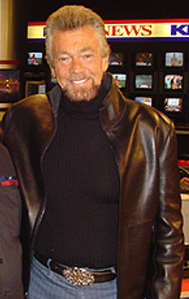
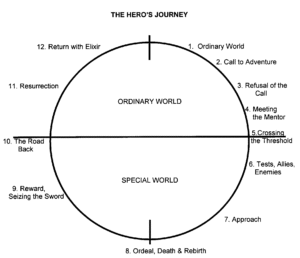
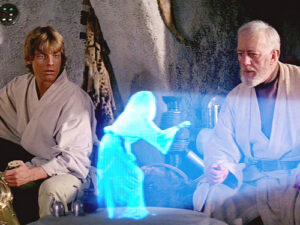
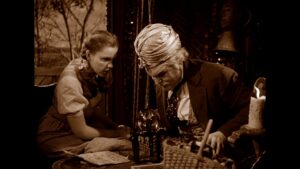
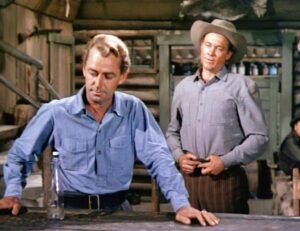
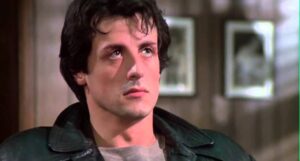
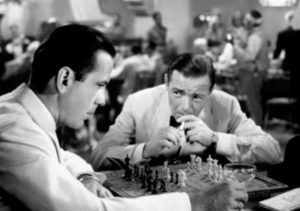 The prime example of Bitter Experience is Casablanca. Rick Blaine had his heart shattered when the woman he loved, Ilsa Lund, abandoned him in Paris just before the Nazi occupation. He has set up shop in Casablanca to forget her. His café is allowed to operate because he takes no sides in the war. His Call to Adventure comes when Ugarte, the scheming rat who murdered German couriers to obtain the valuable Letters of Transit, begs Rick to hide him from the police. Rick refuses with the classic line, “I stick my neck out for nobody.”
The prime example of Bitter Experience is Casablanca. Rick Blaine had his heart shattered when the woman he loved, Ilsa Lund, abandoned him in Paris just before the Nazi occupation. He has set up shop in Casablanca to forget her. His café is allowed to operate because he takes no sides in the war. His Call to Adventure comes when Ugarte, the scheming rat who murdered German couriers to obtain the valuable Letters of Transit, begs Rick to hide him from the police. Rick refuses with the classic line, “I stick my neck out for nobody.” A refusal out of fear or self-doubt must be overcome with a strong emotional jolt. In Finding Nemo, Marlin, Nemo’s father, is afraid of the open ocean because of a past traumatic event—a barracuda attack that killed his wife, Cora, and most of their eggs. He is therefore overprotective of his surviving son, Nemo. Nemo keeps calling his father to adventure—exploring the sea, finding a sea turtle, etc. But Marlin refuses. He is full of fear and self-doubt about his ability to protect his son.
A refusal out of fear or self-doubt must be overcome with a strong emotional jolt. In Finding Nemo, Marlin, Nemo’s father, is afraid of the open ocean because of a past traumatic event—a barracuda attack that killed his wife, Cora, and most of their eggs. He is therefore overprotective of his surviving son, Nemo. Nemo keeps calling his father to adventure—exploring the sea, finding a sea turtle, etc. But Marlin refuses. He is full of fear and self-doubt about his ability to protect his son. Resonance and The Reader’s Journey
Resonance and The Reader’s Journey

